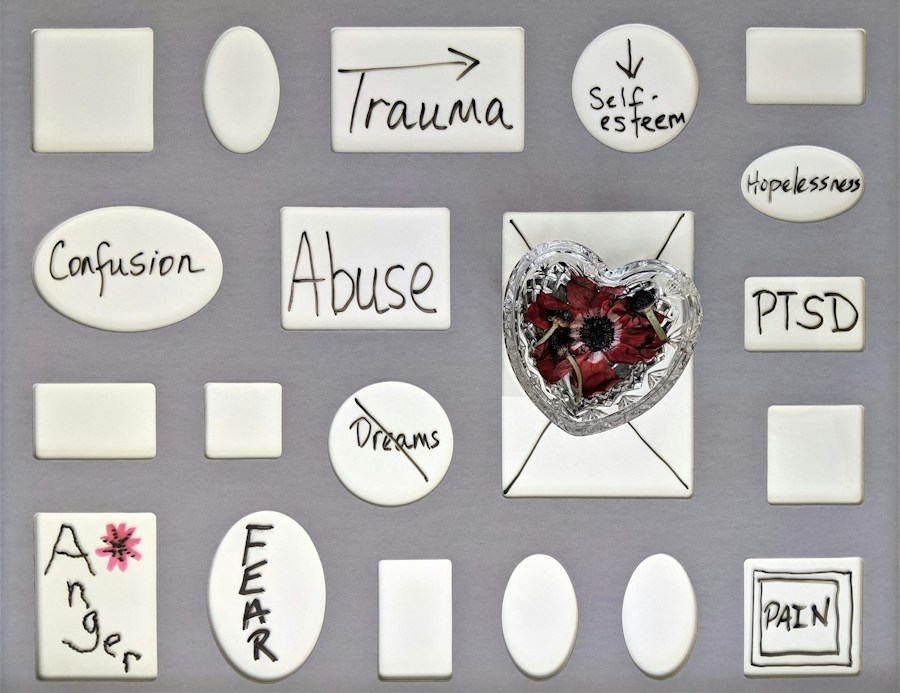ESCAPING THE NARCISSIST
Are you trapped in a toxic relationship? It's time to reclaim your life and find healing. ESCAPING THE NARCISSIST: HOW TO HEAL AND RECOVER FROM NARCISSISTIC ABUSE IN RELATIONSHIPS is your guide to breaking free and starting your journey towards recovery.
Don't let the pain control you any longer. Take the first step today and discover the strategies to overcome emotional abuse and rebuild your life. You deserve happiness and peace.
Start Your Healing Journey TodayCodependency is a term that is often used to describe a dysfunctional relationship dynamic where one person enables the unhealthy behavior of another. It is characterized by an excessive reliance on the approval and validation of others, often at the expense of one’s own needs and well-being. Codependency and narcissism are closely related because they often go hand in hand in toxic relationships.
Narcissism, on the other hand, refers to a personality disorder characterized by an inflated sense of self-importance, a constant need for admiration, and a lack of empathy for others. Narcissists are often manipulative and controlling, using others to fulfill their own needs and desires. Codependents, with their strong desire to please and gain approval, are the perfect targets for narcissists.
The Narcissist’s Web: How Codependency Enables Narcissistic Behavior
Narcissists are skilled at manipulating and controlling their codependent partners. They use tactics such as gaslighting, manipulation, and emotional abuse to keep their partners under their control. Codependents, with their low self-esteem and fear of abandonment, are easily trapped in this cycle of abuse.
The cycle of abuse in codependent relationships typically starts with the narcissist idealizing their partner, showering them with love and attention. This phase makes the codependent feel special and valued, creating a strong emotional bond. However, this idealization is short-lived, as the narcissist soon begins to devalue their partner. They may criticize, belittle, or even emotionally or physically abuse them.
The devaluation phase is followed by the discard phase, where the narcissist withdraws their affection and attention from the codependent. This leaves the codependent feeling confused, hurt, and desperate for the narcissist’s love and approval. The cycle then repeats itself, with the narcissist alternating between idealization and devaluation, keeping the codependent trapped in a toxic and emotionally draining relationship.
The Role of Enablers in Narcissistic Relationships
Enablers play a significant role in narcissistic relationships. They are individuals who support and enable the narcissist’s behavior, often unknowingly. There are different types of enablers in these relationships, including family members, friends, and even therapists.
Family enablers are often the closest to the narcissist and may have grown up in dysfunctional households themselves. They may have learned to adapt to the narcissist’s behavior and enable it as a means of survival. Friends and acquaintances may also enable the narcissist by turning a blind eye to their abusive behavior or making excuses for them.
Therapists can also inadvertently enable narcissistic behavior by not recognizing or addressing the underlying issues. They may focus solely on the codependent’s role in the relationship, failing to hold the narcissist accountable for their actions. This can further perpetuate the cycle of abuse and prevent the codependent from breaking free.
Signs of Codependency: How to Recognize if You’re in a Narcissistic Relationship
Recognizing codependency is crucial for breaking free from a narcissistic relationship. Some common signs of codependency include:
1. Low self-esteem: Codependents often have a poor sense of self-worth and rely on others for validation and approval.
2. People-pleasing: Codependents go to great lengths to please others, often at their own expense.
3. Difficulty setting boundaries: Codependents struggle to set and maintain healthy boundaries, allowing others to take advantage of them.
4. Fear of abandonment: Codependents have an intense fear of being alone or abandoned, which makes it difficult for them to leave toxic relationships.
5. Neglecting one’s own needs: Codependents prioritize the needs of others over their own, often neglecting their own well-being in the process.
If you resonate with these signs, it is essential to seek support and take steps towards healing and breaking free from the cycle of codependency.
The Emotional Toll of Codependency on the Victim
Codependency takes a significant toll on the mental health and emotional well-being of the victim. The constant need for validation and approval from others can lead to feelings of anxiety, depression, and low self-esteem. Codependents often lose touch with their own needs and desires, becoming disconnected from their authentic selves.
In narcissistic relationships, emotional abuse is prevalent. Narcissists use manipulation, gaslighting, and other tactics to control and demean their partners. This emotional abuse can cause long-lasting trauma and damage to the codependent’s self-esteem and sense of self-worth.
The emotional toll of codependency can also manifest in physical symptoms such as chronic stress, insomnia, and even physical pain. It is crucial for codependents to recognize the impact of their relationship on their mental and physical health and take steps towards healing.
Breaking Free: How to End a Codependent Relationship with a Narcissist
Ending a codependent relationship with a narcissist can be challenging, but it is possible with the right support and strategies. Here are some steps to consider:
1. Educate yourself: Learn about codependency, narcissism, and toxic relationships. Understanding the dynamics at play will help you gain clarity and perspective.
2. Seek support: Reach out to trusted friends, family members, or professionals who can provide emotional support and guidance throughout the process.
3. Create a safety plan: If you are in immediate danger or fear for your safety, create a safety plan that includes contacting local authorities or seeking refuge in a safe space.
4. Establish boundaries: Set clear boundaries with the narcissist and communicate your needs and expectations. Be prepared for resistance and pushback, but stay firm in your boundaries.
5. Cut off contact: Limit or cut off contact with the narcissist to create space for healing and recovery. This may involve blocking their phone number, unfollowing them on social media, or even changing your daily routines to avoid running into them.
6. Focus on self-care: Prioritize self-care activities that nourish your mind, body, and soul. This may include therapy, exercise, meditation, journaling, or engaging in hobbies that bring you joy.
7. Seek professional help: Consider working with a therapist who specializes in codependency and trauma to help you navigate the healing process and build healthier relationship patterns.
Healing from Codependency: Strategies for Recovery and Self-Care
Healing from codependency is a journey that requires time, patience, and self-compassion. Here are some strategies for recovery and self-care:
1. Practice self-compassion: Be kind and gentle with yourself as you navigate the healing process. Recognize that healing takes time and that setbacks are a natural part of the journey.
2. Set realistic expectations: Understand that healing is not linear and that there will be ups and downs along the way. Set realistic expectations for yourself and celebrate small victories.
3. Engage in therapy: Working with a therapist who specializes in codependency can provide valuable support and guidance as you heal from past wounds and develop healthier relationship patterns.
4. Build a support network: Surround yourself with supportive friends, family members, or support groups who understand your journey and can provide encouragement and validation.
5. Practice self-care: Prioritize self-care activities that nourish your mind, body, and soul. This may include exercise, meditation, journaling, or engaging in hobbies that bring you joy.
6. Set and maintain boundaries: Learn to set and maintain healthy boundaries in all areas of your life. Practice saying no and prioritize your own needs and well-being.
7. Cultivate self-love: Focus on building a loving and compassionate relationship with yourself. Practice self-acceptance, self-forgiveness, and self-love on a daily basis.
The Importance of Boundaries in Narcissistic Relationships
Setting and maintaining healthy boundaries is crucial in preventing codependency and enabling behavior in narcissistic relationships. Boundaries are the limits we set for ourselves and others, defining what is acceptable and what is not. In narcissistic relationships, boundaries are often violated, leading to a loss of self-identity and a sense of powerlessness.
To set healthy boundaries, it is important to:
1. Identify your values and needs: Understand what is important to you and what you need in a relationship. This will help you establish clear boundaries that align with your values.
2. Communicate your boundaries: Clearly communicate your boundaries to the narcissist, expressing what is acceptable and what is not. Be firm and assertive in your communication.
3. Enforce consequences: If your boundaries are violated, enforce consequences that are appropriate for the situation. This may involve limiting contact, ending the relationship, or seeking legal intervention if necessary.
4. Practice self-care: Prioritize self-care activities that nourish your mind, body, and soul. Taking care of yourself will help you maintain healthy boundaries and protect your well-being.
5. Seek support: Surround yourself with a support network of friends, family members, or professionals who can provide guidance and encouragement as you navigate boundary-setting in your relationship.
Building Healthy Relationships: How to Avoid Codependency and Narcissistic Patterns
Building healthy relationships starts with self-awareness and a commitment to personal growth. Here are some tips for avoiding codependency and narcissistic patterns:
1. Develop a strong sense of self: Cultivate a strong sense of self-worth and self-identity. Know your values, needs, and boundaries, and prioritize them in your relationships.
2. Practice self-love: Love and accept yourself unconditionally. Treat yourself with kindness, compassion, and respect.
3. Choose healthy partners: Be selective in choosing your partners and surround yourself with individuals who respect and value you for who you are.
4. Communicate openly and honestly: Practice open and honest communication in your relationships. Express your needs, desires, and concerns, and encourage your partner to do the same.
5. Set and maintain boundaries: Establish clear boundaries in your relationships and communicate them to your partner. Respect each other’s boundaries and enforce consequences if they are violated.
6. Prioritize self-care: Take care of yourself physically, mentally, and emotionally. Engage in activities that bring you joy, practice self-care rituals, and seek support when needed.
7. Seek therapy or counseling: Consider working with a therapist or counselor who can help you navigate relationship dynamics, build healthy communication skills, and address any underlying issues that may contribute to codependency or narcissistic patterns.
The Impact of Narcissistic Relationships on Children and Family Dynamics
Narcissistic behavior not only affects the individuals directly involved in the relationship but also has a significant impact on children and other family members. Growing up in a narcissistic household can have long-term effects on a child’s emotional well-being and development.
Children of narcissists often experience emotional neglect, as the narcissist’s needs take precedence over theirs. They may also witness or be subjected to emotional or physical abuse, which can lead to trauma and long-lasting psychological effects.
In narcissistic households, family dynamics are often centered around the narcissist’s needs and desires. Other family members may be forced to enable the narcissist’s behavior or face the consequences of their anger and manipulation. This can create a toxic and dysfunctional environment where healthy communication and emotional support are lacking.
Moving Forward with Knowledge and Empowerment
Educating oneself on codependency and narcissism is crucial for breaking free from toxic relationships and moving forward with knowledge and empowerment. By understanding the dynamics at play, recognizing the signs of codependency, and setting healthy boundaries, individuals can protect themselves from further harm and build healthier relationships.
Healing from codependency takes time and effort, but with the right support and strategies, it is possible to break free from the cycle of abuse and reclaim one’s sense of self. By prioritizing self-care, seeking therapy, and practicing self-compassion, individuals can heal from past wounds and build healthier relationship patterns.
Moving forward, it is important to be mindful of the red flags of codependency and narcissism in future relationships. By choosing healthy partners, practicing open communication, and prioritizing self-love, individuals can build relationships that are based on mutual respect, trust, and emotional well-being.


